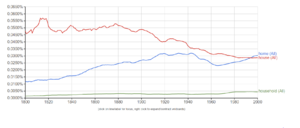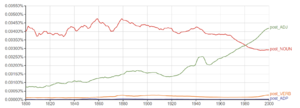COGS200/2017W1/NGramAssignment/izst
Synonyms
b) home,house,household
c) The graph shows a decrease in the use of the word house and an increase in the use of the word home, while the word household has remained relatively the same with very low use. This means the state for describing a home has 2 main attractors "house" and "home" and "home" has slowly progressing into becoming the dominant attractor basin of the system.
d) This shift in the attractors could be due to the growing number of homes that do not fall under the title of house, such as apartment, townhouse, duplex, etc., New types of homes require a more inclusive term, in this case "home", by which to be described. The shift comes at a time when other types of homes have incereased in popularity due to growing population density.
Wildcard
b) global *
c) The graph shows a number of different states for the composition with the word global. In the mid 40s, one attractor was "war", however this has changed and now the two most dominating attractors are "economy" and "warming".
d) This change could be due to the decreased worry in global war in the 20th century. "economy" is likely and attractor because of the increased connectivity of economic markets, and growing interdependence of industries. Although seemingly random, the similar rise in "warming" is also understandable with the growing worry about global warming and high volume of literature that is published on it due to its controversial status.
Inflection
b) drive_INF
c) The graph shows that there has been a lot of fluctuation in the state of how the stem of "drive" is used. In recent years "drive" has become the main attractor, and has replaced "driven". The trend indicates that "drive" is and should continue to be quite a stable state, as it attracts more than all other states.
d) Surprisingly, drive does has not become the attractor basin because of the invention of the automobile and related technologies. Although, the use of drive served as the start of its rise into this stable state, with literature written about cars, drive in theaters and restaurants, the literature now is not concentrated around one use of drive. Instead it is used as a trait (as a noun of personal drive), as well as a verb (drive to work). Therefore, it can only be concluded that the attraction to "drive" is due to its versatility in language.
Part Of Speech
b) post_*
c) This graph also shows a shift in the attractor basins in the use of post. In recent years, the post_NOUN state has become less stable and the post_ADJ more stable, switching places at around the year 1980.
d) This is somewhat surprising, as it would be expected that with the rise of social media the post_VERB state would be the most stable attractor. Instead, its post_NOUN and post_ADJ. This could be to the fact that more literature is written about things that are already posted on the internet, not as much the act of posting. In such a case, one would see more the use of words such as posted (adj.) or post (noun) used.
Part of Speech (not specific word)
b) violence in *_NOUN
c) The graph shows a great instability in the state of how "violence in" is used. Although the attractor "violence in society" is the most stable at around year 2000, it is not a clear attractor basin. The graph shows "violence in order" to be the second most stable state in the entire history of the system, but has lost that status to "violence in society" in recent years. Other states such as "violence in America," "violence in norther" and "violence in Northern" have drastically gained stability in recent years.
d) The relative stability of "violence in order" can be attributed to the great amount of literature explaining and justifying the use of violence. It is interesting to see that despite the fact that the world is relatively much less violent now than in the past, there is a sharp increase in literature about violence in society. Much of this recent increase in the graph is due to the literature about violence in television and media.




